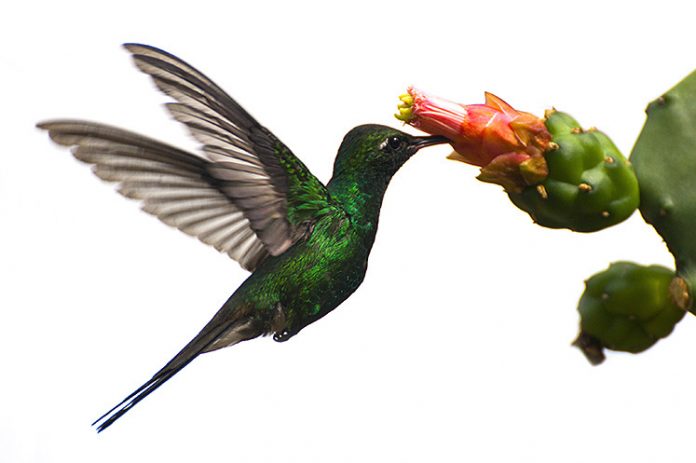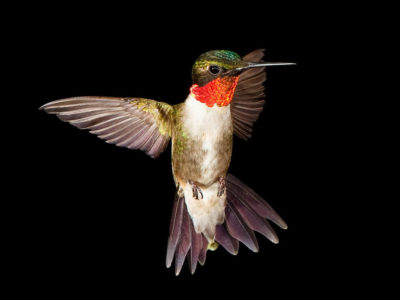
ZUNZUNCITO, COLIBRI, TROVADOR O ZUMBETE, EL AVE VIVA MAS PEQUEÑA DEL MUNDO, NATURAL DE CUBA. PHOTOS.
El zunzuncito o colibrí abeja (Mellisuga helenae) es una especie de colibrí, nativa de la isla de Cuba en el Caribe. Es el ave más pequeña conocida. El colibrí abeja se alimenta del néctar de las flores y los insectos que se encuentran en Cuba.
El colibrí abeja es el ave viva más pequeña. Las hembras pesan 2,6 g (0,092 oz) y miden 6,1 cm (2+3⁄8 in) de largo, y son ligeramente más grandes que los machos, que tienen un peso promedio de 1,95 g (0,069 oz) y una longitud de 5,5 cm (2+1⁄8 in). Como todos los colibríes, es un volador rápido y fuerte.
En inglés se le conoce por Bee Hummingbird. Con una rapidez inaudita, alcanza una velocidad de vuelo de hasta 114 kilómetros por hora y toma el néctar de las flores en plena suspensión utilizando su largo y fino pico.
Constituye un Polinizador por excelencia, pues a la vez que se alimenta ayuda a la reproducción de las plantas.
Esta avecilla, que mide apenas siete centímetros, constituye el pájaro más pequeño del mundo. Al igual que otras aves endémicas, el Zunzuncito se encuentra protegido por hallarse en peligro de extinción.
EL ZUNZÚNCITO CUBANO…
El zunzúncito o pájaro mosca, que existe en Cuba, alcanza 7 cm de longitud. Su plumaje es negro al dorso y roja en la parte superior de la cabeza; las alas y la cola son de un verde azul metálico, y el pico azul marino. Vive en algunos lugares aislados de la península Guanahacabibes, la Ciénaga de Zapata y la Sierra Maestra.
Es poco usual ver este pequeño animalito en los normales rincones de la foresta cubana, son tan veloces y maravillosamente tan sutilez que el llamado colibrí, zunzún cubano o pájaro mosca, conocido también como ‘Tusito’, en el caso exclusivo de Cuba, el zunzuncito, el más diminuto de todo el orbe.
Después que las hembras han sido fecundadas, construyen un pequeño nido forrado interiormente de tela de araña, algodón, liquen o musgo. Allí ponen solamente dos huevos, que empolla entre 14 y 19 días, aproximadamente.
Los zunzunes son de gran importancia para el ecosistema, especialmente en los bosques tropicales, donde constituyen excelentes polinizadores al mantener una estrecha relación con ciertas plantas y flores.
El zunzún fue descubierto por el naturalista y científico alemán Juan Cristóbal Gundlach en 1844, y se dio a conocer por primera vez en el libro Las Aves de Cuba, escrito por el naturalista y profesor gallego Juan Lembeye en 1850. Pertenece a la familia Colibrí, que tiene más de 300 especies.
Durante el vuelo quieto y sostenido, las alas de los colibríes baten a 55 veces por segundo, a 61 veces por segundo cuando se mueven hacia atrás, y al menos a 75 veces por segundo al ir hacia adelante. El nido de estas diminutas aves es algo más grande que un dedal, alcanza para dos huevos que miden entre ocho y diez milímetros.
Resulta curiosa también la forma que tienen de atacar a un ave grande. Con frecuencia se posan sobre el enemigo, y le asestan fuertes golpes con el pico. Es por eso que no debemos asombrarnos cuando vemos un colibrí montado sobre un ave mucho mayor y este deje tras de sí una larga nube de pluma arrancadas a puro picotazos del pequeño zunzuncito, para nosotros es toda una verdadera maravilla de la naturaleza.

ZUNZUNCITO, HUMMINGBIRD, TROUBADOR OR ZUMBETE, THE SMALLEST LIVING BIRD IN THE WORLD, NATURAL FROM CUBA. PHOTOS.
The zunzuncito or bee hummingbird (Mellisuga helenae) is a species of hummingbird, native to the island of Cuba in the Caribbean. It is the smallest known bird. The bee hummingbird feeds on the nectar of flowers and insects found in Cuba.
The bee hummingbird is the smallest living bird. Females weigh 2.6 g (0.092 oz) and measure 6.1 cm (2+3⁄8 in) long, and are slightly larger than males, which have an average weight of 1.95 g (0.069 oz) and a length of 5.5 cm (2+1⁄8 in). Like all hummingbirds, it is a fast and strong flyer.
In English it is known as the Bee Hummingbird. With an incredible speed, it reaches a flight speed of up to 114 kilometers per hour and takes nectar from flowers in full suspension using its long and thin beak.
It is a pollinator par excellence, since at the same time that it feeds, it helps the reproduction of plants.
This little bird, which measures just seven centimeters, is the smallest bird in the world. Like other endemic birds, the Zunzuncito is protected because it is in danger of extinction.
THE CUBAN ZUNZUNCITO…
The zunzuncito or fly bird, which exists in Cuba, reaches 7 cm in length. Its plumage is black on the back and red on the top of the head; the wings and tail are metallic blue-green, and the beak is navy blue. It lives in some isolated places of the Guanahacabibes peninsula, the Ciénaga de Zapata, and the Sierra Maestra.
It is unusual to see this little animal in the normal corners of the Cuban forest, they are so fast and marvelously so subtle that the so-called hummingbird, Cuban hummingbird or fly bird, also known as ‘Tusito’, in the exclusive case of Cuba, the hummingbird, is the smallest of the entire world.
After the females have been fertilized, they build a small nest lined with spider webs, cotton, lichen, or moss. There they lay only two eggs, which hatch between 14 and 19 days, approximately.
The hummingbirds are of great importance for the ecosystem, especially in tropical forests, where they are excellent pollinators by maintaining a close relationship with certain plants and flowers.
The hummingbird was discovered by the German naturalist and scientist Juan Cristóbal Gundlach in 1844 and was first made known in the book Las Aves de Cuba, written by the Galician naturalist and professor Juan Lembeye in 1850. It belongs to the Hummingbird family, which has more than 300 species.
During the steady, steady flight, hummingbirds beat 55 times per second, 61 times per second when moving backward, and at least 75 times per second when moving forward. The nest of these tiny birds is somewhat larger than a thimble, enough for two eggs that measure between eight and ten millimeters.
It is also curious how they attack a large bird. They often perch on the enemy, hitting them hard with their beaks. That is why we should not be surprised when we see a hummingbird mounted on a much larger bird and it leaves behind a long cloud of feathers plucked by pure pecks from the little zunzuncito, for us it is a true wonder of nature.

Agencies/ Wiki/ CubaTesoro/ Rad.Enciclop./ Juan Rodríguez/ Extractos/ Excerpts/ Internet Photos/ Arnoldo Varona.
www.TheCubanHistory.com
THE CUBAN HISTORY, HOLLYWOOD.




 ZUNZUNCITO, COLIBRI, TROVADOR O ZUMBETE, EL AVE VIVA MAS PEQUEÑA DEL UNDO, NATURAL DE CUBA. PHOTOS. * ZUNZUNCITO, HUMMINGBIRD, TROUBADOR OR ZUMBETE, THE SMALLEST LIVING BIRD IN THE WORLD, NATURAL FROM CUBA. PHOTOS.
ZUNZUNCITO, COLIBRI, TROVADOR O ZUMBETE, EL AVE VIVA MAS PEQUEÑA DEL UNDO, NATURAL DE CUBA. PHOTOS. * ZUNZUNCITO, HUMMINGBIRD, TROUBADOR OR ZUMBETE, THE SMALLEST LIVING BIRD IN THE WORLD, NATURAL FROM CUBA. PHOTOS.